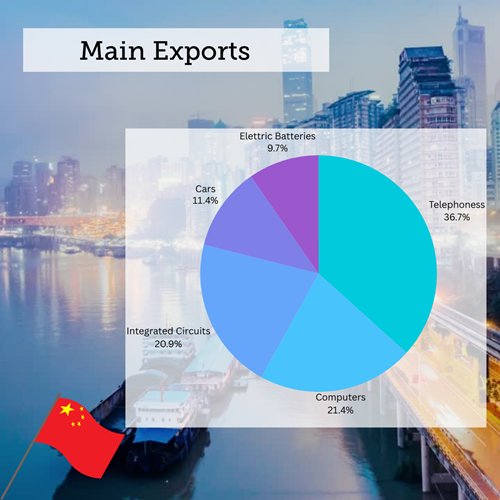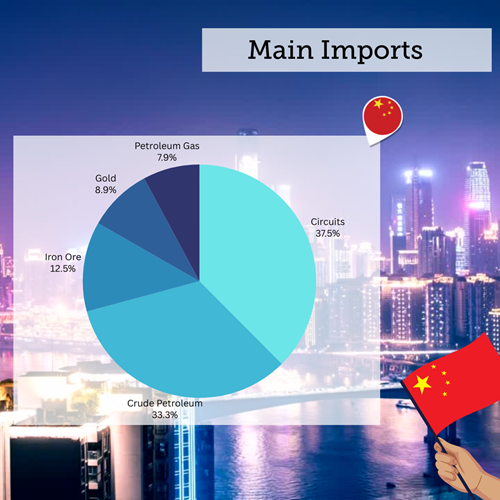Analysis and Studies - Country Analysis
China: a look at the market
November 28th 2023
China, officially the People’s Republic of China, is a country located in the East of Asia. It’s the world’s second most thickly settled country, with a population going past 1.4 billion.
China spans the equivalent of five times zones and borders fourteen countries by land, tied with Russia as having the most of any country in the world. Moreover it’s the world’s third largest country by total land area. The country is split up into 22 provinces, five autonomous regions, four municipalities, and two semi-autonomous special administrative regions. The national capital is Beijing and the most thronged city and largest financial center is Shanghai.
What about Economy, China has the word’s second largest economy in terms of nominal GDP, and also the world’s largest in terms of purchasing power parity (PPP). It is a measure of the price of specific goods in unidentical countries and is used to hold up together the absolute purchasing power of the countries’ bank notes.

PPP is effectively the ratio of the price of a basket of goods at one location divided by the price of basket of goods at a different location.
A look at the market
As the same time as China is one of the world’s fastest spreading outstanding economies, with its economic growth having been almost consistently above six percent since the groundwork of economic reforms in 1978. Based on World Bank, China’s GDP grew from $150 billion in 1978 to $17.96 trillion in 2022.
In relation to 500 largest companies in the world, 142 are executive office in China.
Furthermore, China was one of the world’s leading economic powers throughout the arc of East Asian and global history. The country had one of the largest economies in the world of the past two millennia, during this period it has seen concatenations of success and decline.
After the economic reform in 1978, China has developed into a highly diversified economy and one of the most consequential team member in international trade.
Major sectors of competitive strength include manufacturing, retail, mining, steel, textiles, automobiles, energy generation, banking, electronics, e-commerce and tourism. China has also three out of the largest stock exchanges in the world – Shanghai, Hong Kong and Shenzhen – that concurrently have a market capitalization of over $15.9 billion, as October 2020.
Newfangled China is often describes as an example of state capitalism or party-state capitalism. The other ones have marked out it as a form of Marxism-Leninism adapted to co-exist with global capitalism. The state calls the shots in strategic mainstay sectors such as energy production and heavy industries, even so private enterprise has bulked out monumentally, with 30 million private businesses recorded in 2008.
Concerning exports and imports in 2023, China sold internationally $299 billion and shipped in $221 billion, outcoming in a positive trade balance of $77.8 billion. Nevertheless, between September 2022 and September 2023 the exports of China have decreased by $-23.6 billion (-7.32%) from $323 billion to $299 billion, as long as imports dropped-off by $-16.7 billion (-7.02%) from $238 billion to $221 billion.
In September 2023, the main exports of China were Telephones ($23.7B), Computers ($13.8B), Integrated Circuits ($13.5B), Cars ($7.36B), and Electric Batteries ($6.26B). In September 2023 the top imports of China were Integrated Circuits ($32.5B), Crude Petroleum ($28.8B), Iron Ore ($10.8B), Gold ($7.68B), and Petroleum Gas ($6.8B).

Besides, in September 2023, China traded overseas mostly to United States ($46B), Hong Kong ($27.6B), Japan ($14.3B), South Korea ($12.6B), and Vietnam ($12.4B), and imported mostly from Taiwan ($18.6B), South Korea ($15.4B), Japan ($14.3B), United States ($12.8B), and Australia ($12.2B).

In September 2023 the exports of China were on the whole from Guangdong Province ($76.4B), Zhejiang Province ($44.2B), Jiangsu Province ($41.5B), Shandong Province ($22.3B), and Shanghai Province ($22.2B); on the other and imports destinations were chiefy Guangdong Province ($36.2B), Beijing ($34B), Shanghai Province ($29.9B), Jiangsu Province ($23.6B), and Zhejiang Province ($17.4B).
Fonti:
https://oec.world/en
https://data.worldbank.org/
https://www.trademap.org/
